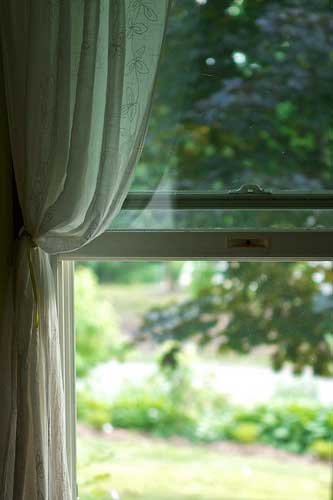Did you know that the air quality inside of our homes might actually be worse than the air quality outdoors? Old appliances, poor ventilation systems, cleaning products, dust, pets as well as any outdoor irritants that are tracked into the home can lead to trapped air pollutants.
Poor air quality can result in coughing fits, chest tightness, a sore throat, watery or itchy eyes, a stuffy nose and difficulty breathing. Living in a home with consistently poor air quality can lead to difficulty recovering from illness, allergies, bronchitis and asthma.

Open a window to let outside air in
Common Pollutants Found in Our Homes
Even the most innocuous-looking items can produce allergens. Common home appliances, like space heaters, gas ranges, ovens, furnaces, fireplaces and water heaters can release gas and other irritants indoors.
Molds and mildew in poorly-ventilated areas with high humidity levels can add to allergic reactions. Even if the mold is contained in a distant, low traffic area of the house, the spores can easily travel to the rest of the home through your ventilation system.
If you have pets, their dander and hair in the air can trigger allergies. If the pet spends any portion of its day outside, they are also tracking in allergens, like pollen and dust, back into the house.
While cleaning the house can rid you of dust mites, dust, molds and other irritants and many household cleaning products (especially those with chemicals such as chlorine and ammonia) can add to indoor pollution. Many of these cleaners contain and can release volatile organic compounds (VOC), which are harmful to your health. Paint, dry-cleaned clothing, and, ironically, air fresheners also may contain VOCs.
Tobacco smoke is another common allergen and irritant. Exposure to smoke increases a child’s risk for developing asthma. It can also lead to lung cancer or lung disease—which includes chronic bronchitis and emphysema.
Signs of Poor Air Quality
How do you know if you have poor air quality? Keep an eye (or a nose) out for any of the signs below:
– Noticeable, stable, or musty odors.
– “Stuffiness” and lack of air movement.
– When you turn on central heating, or air conditioning systems the initial smell is musty or dusty.
– Dust covered vents for central heating or air conditioning.
– Presence of molds and mildew.
– Allergic reaction or increase in allergy-type symptoms after using a household product or cleaner.
Ways to Improve Air Quality

House with improved air quality – Courtesy of Design Inspiration Gallery/Flickr.com
Taking a few simple steps to improve your air quality will improve your health as well. Improving ventilation, using natural cleaners (like baking soda), controlling moisture using a humidifier or a vaporizer and frequently inspecting household appliances can help change your air quality for the better. Clean and change the filters in your air conditioner, air purifier and vacuum as often as it is suggested by the manufacturer’s instruction manual.
Maintain ideal humidity levels to prevent the growth of bio-allergens like mildew and mold. A moisture or humidity gauge can give you a sense of whether you need a vaporizer or humidifier to increase moisture in the air, or an air conditioner or dehumidifier to decrease the moisture. Ideally, in-home humidity levels should be around 45-percent—under 30-percent is too dry and over 50-percent can contribute to mold growth. Consider running the AC every once in awhile as a well-cleaned air conditioner can help remove pollutants and pollen from the air.
When choosing household products, opt for organic, natural brands, or homemade versions of cleaners. Choose paints that have low or no VOCs and check the label on all household cleaners, adhesives, finishes for ingredients that may emit noxious fumes or gases.
Invest in an air purifier that will help remove VOCs, pollen and other allergens from the air indoors. Simple green plants can also help remove pollutants out of the air in your home.
And finally, groom your pets frequently and avoid smoking indoors to improve air quality.
By increasing ventilation and avoiding use of irritating substances, you will lower levels of known irritants. Sometimes, just opening the window for a few minutes can make a difference in the indoor air quality. Make these changes today for better air quality and better health.
Marcela De Vivo is a freelance writer from the Los Angeles as well as the founder of Gryffin Media. Her writing covers everything from home improvement, to personal health, to social media. As a mom and someone who works from home, the air quality of her house is essential!